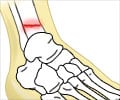
Over 80 percent of the injuries were on the ankle or foot, with just under 20 percent involving the knee, trunk, shoulder, or head and neck. More than half were strains or sprains, with fractures accounting for 19 percent of all injuries.
Vice chair and Professor Gerald McGwin, Ph.D., who led the study, said that although heels might be stylish, from a health standpoint, it would be worthwhile to understand the risks and the potential harm that precarious activities in high-heeled shoes can cause.
Many studies have documented that the long-term use of high heels alters the neuromechanics of walking and places greater strain on the muscles and tendons of the lower legs, which can lead to musculoskeletal disorders later in life.
Source-Medindia









